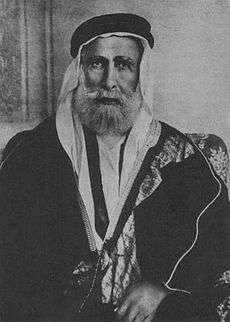Alids
| Part of a series on |
| Ali |
|---|
 |
|
Related articles |
|
The Alids are the dynasties descended from Ali ibn Abi Talib, son-in-law of the Islamic prophet Muhammad (see Family tree of Muhammad and Family tree of Husayn ibn Ali). Shia Muslims consider him the First Imam appointed by Muhammad and the first rightful caliph.
Lines of Descent

Primarily Sunnis in the Arab world reserve the term sharif or "sherif" for descendants of Hasan ibn Ali, while sayyid is used for descendants of Husayn ibn Ali. Both Hasan and Husayn are grandchildren of Prophet Muhammad, through the marriage of his cousin Ali and his daughter Fatima. However ever since the post-Hashemite era began, the term sayyid has been used to denote descendants from both Hasan and Husayn. Arab Shiites use the terms sayyid and habib to denote descendants from both Hasan and Husayn; see also ashraf.
To try to resolve the confusion surrounding the descendants of Muhammad, the Ottoman Caliphs during the 19th Century C.E. attempted to replicate the Almanach de Gotha (the tome listing the Noble houses of Europe) to show known and verifiable lines of descent. Although not 100% complete in its scope (some lines might have been excluded due to lack of proof, although no false lines are included) the resulting "Kitab al-Ashraf" (Book of the Sharifs), kept at the Topkapi Palace Museum in Istanbul is one of the best sources of evidence of descent from Muhammad.
There are several dynasties of Alid origin:
- The Zaydid dynasty of Tabaristan are descents of Ali ibn Abi Talib. His son, Hasan ibn Ali, has a son named Zaid who gave name to the dynasty. Hasan ibn Zayd was the son of Zayd who gave origin to the Zaydids in Tabaristan (Alavids).
- The Ukhaydhirite dynasty which ruled Al-Yamamah in central Arabia from 862 C.E. till the mid-11th century traced its lineage to Ali through his son Al-Hassan.
- The Sulaymanid dynasty of Yemen has origin in Hasan ibn Hasan, brother of Zayd ibn Hasan (see Zaydid dynasty above). Hasan had a son named Daud ibn Hasan, who was Sulayman ibn Daud's father, who the dynasty is named after.
- The Alid dynasty of Yemen originated with Hasan ibn Hasan, brother of Zayd ibn Hasan (see Zaydid dynasty above). Hasan had a son named Ibrahim ibn Hasan, that had a son called Ismail ibn Ibrahim, father of Ibrahim Tabataba ibn Ismail. Tabataba was father of Kassim al Rassi, originally of the dynasty Rassid of the Imams of Yemen.
- The Alid Dynasty of the Isaaq clan or Banu Isaaq clan of Somalia, who are descended from Ali through their ancestor Isaaq ibn Ahmad al Hashimi. Today, the Isaaq clan form the majority of the northern territory of Somaliland.
- The Alid dynasty of Sharifs of Sousse (Tunisia) originated with Hasan ibn Hasan, brother of Zayd ibn Hasan (see Zaydid dynasty above). Hasan had a son named Abdallah ibn Hasan, who had a son called Djafar ibn Abdallah. This Djafar ibn Abdallah, grandson of Hasan ibn Hasan, began this dynasty.
- The Alid dynasty of Sharifs of Morocco (the Alaouite dynasty[1]) began also with Hassan ibn Hassan, brother of Zayd ibn Hasan. Its first member was Muhammad ibn Abdallah, brother of Djafar ibn Abdallah (see above).
- The founder of the Idrisid dynasty of Morocco was Idris ibn Abdallah. He was the brother of Djafar ibn Abdallah (see above).
- The Hammudid dynasty of Algeciras, Málaga, Sevilla and Kingdom of Granada has same origin. Their ancestor, Hammud, was a descendant of Idris ibn Abdallah.
- The Sulaymanids dynasty of, Tlemcen, Archgoul, Tenes (West-Algeria) Sulayman ibn Abd Allah the first amir of the dynasty sulaymanid he was the brother of Idris i of Fas[2]
- The Banu Katuda/Hashemites, Sharifs of Mecca and Kings of Jordan, Kings of Iraq, Kings of Hejaz, Kings of Syria, have origin in Musa ibn Abdallah, brother of Idris ibn Abdallah (se above). Musa had a son named Abdallah ibn Musa, father of Musa ibn Abdallah ibn Musa, who began this dynasty. From this branch also came the Banu Fulayta.
- The Alid Dynasty of the Muse clan or Banu Muse clan of Somalia, who are descended from Ali through there ancestor Muse ibn Mohammed al Hashimi. Today, the Muse clan formed the minority of the northern territory of Somaliland.
- The Banu Salih of the old state of Ghana originated in Salih ibn Abdallah, brother of Musa ibn Abdallah ibn Musa (see above).
- The Sulaymanid dynasty of Sharifs of La Mecca originated in Sulayman ibn Abdallah, brother of Salih ibn Abdallah (see above).
- The Al Qasimi (Qawasim) dynasty of Sharjah and Ras al-Khaimah claim descent from the 10th Imam, Ali al-Hadi.
- The Fatimid Caliphs (Later the Ismaili imams of Alamut) claimed descent from Husayn ibn Ali, son of Ali ibn Abi Talib. The line was:

- Ali ibn Abi Talib,
- Husayn ibn Ali,
- Ali Zayn al Abidin ibn Husayn,
- Muhammad el Bakir ibn Ali,
- Djafar el Sadik ibn Muhammad,
- Ismail ibn Djafar,
- Muhammad ibn Ismail,
- Ahmad al-Wafi (Abadullah ibn Muhammad ibn Ismail),
- Muhammad at-Taqi (Ahmed ibn Abadullah ibn Muhammad),
- Raḍī ʿAbd Allāh az-Zaki (Husayn ibn Ahmad ibn Abadullah) and
- Ubayd Allah al-Mahdi Billah.
- Djafar el Sadik ibn Muhammad,
- Muhammad el Bakir ibn Ali,
- Ali Zayn al Abidin ibn Husayn,
- Husayn ibn Ali,
- The Safavids dynasty claimed descent from Husayn ibn Ali, son of Ali ibn Abi Talib, sharing the first five original rulers with the Fatimids (compare the indented names). There is no known independent documentation that supports this claim, and it is presented here for historical completeness. The Safavid dynasty family tree shows part of this. The line was:
- Ali ibn Albi Talib,
- Husayn ibn Ali,
- Ali Zayn al Abidin ibn Husayn,
- Muhammad el Bakir ibn Ali,
- Djafar el Sadik ibn Muhammad,
- Musa ibn Ja'far al-Kazim,
- Hamzah ibn Musa,
- Mohammad al-Qasim ibn Hamzah ,
- Ahmed ibn Mohammad,
- Mohamed ibn Ahmed ,
- Ismail ibn Mohamed,
- Ja'far ibn Ismail,
- Ibrahim ibn Ja'far ,
- Mohamed ibn Ibrahim ,
- Ali ibn Mohamed,
- Mohamed ibn Mohamed,
- Feroz Shah ibn Mohamed,
- Awoad ibn Feroz Shah ,
- Mohamed ibn Awoad ,
- Rashid ibn Mohamed,
- Ahmed ibn Rashid ,
- Gabriel ibn Ahmed,
- Isaac ibn Gabriel ,
- Safi al-Din ibn Isaac,
- Sadruddin ibn Safi al-Din ,
- Ali ibn Sadruddin,
- Ibrahim ibn Ali,
- Sadruddin ibn Ibrahim,
- Haider ibn Sadruddin,
- Shah Ismail Safavid ibn Haider.
- Djafar el Sadik ibn Muhammad,
- Muhammad el Bakir ibn Ali,
- Ali Zayn al Abidin ibn Husayn,
- Husayn ibn Ali,
Genealogical Trees
This is a table of the interrelationships between the different parts of the Alid dynasties:[3]
Below is a simplified family tree of Husayn ibn Ali. For the ancestors of ibn Ali see the family tree of Muhammad and the family tree of Ali. People in italics are considered by the majority of Shia and Sunni Muslims to be Ahl al-Bayt (People of the House). Twelver Shia also see the 4th to 12th Imamah as Ahl al-Bayt.
Family tree of Husayn ibn Ali
| Muhammad grandfather (family tree) | Khadijah bint Khuwaylid grandmother | ||||||||||||||||||||||||||||||||||||||||||||||||||||
| Fatimah mother | Ali father (family tree) (descendants) 1st Shia Imāmah, 4th Sunni Rashidun | ||||||||||||||||||||||||||||||||||||||||||||||||||||
| Muhsin ibn Ali brother | Hasan ibn Ali brother 2nd Twelver/Zaidiyyah and 1st Mustaali Imāmah | Husayn ibn Ali 3rd Twelver/Zaidiyyah and 2nd Mustaali/Nizari Imāmah | Umm Kulthum bint Ali sister | Zaynab bint Ali sister | |||||||||||||||||||||||||||||||||||||||||||||||||
| Shahrbanu wife | Rubab bint Imra al-Qais wife | Layla bint Abi Murrah al-Thaqafi wife | Umm Ishaq bint Talhah wife | ||||||||||||||||||||||||||||||||||||||||||||||||||
| Fatema Sugra bint Husayn daughter | Sakinah bint Husayn daughter | Ali al-Asghar ibn Husayn son | Sukayna bint Husayn daughter | Ali al-Akbar ibn Husayn son | Fatimah bint Husayn daughter | ||||||||||||||||||||||||||||||||||||||||||||||||
| Mother of ‘Umar | Ali ibn Husayn son 4th Twelver/Zaidiyyah and 3rdMustaali/Nizari Imāmah | Fatimah bint al-Hasan daughter-in-law | Jayda al-Sindhi | Umar ibn Husayn son | |||||||||||||||||||||||||||||||||||||||||||||||||
| ‘Umar al-Ashraf | Muhammad al-Baqir grandson 5th Twelver and 4th Mustaali/Nizari Imāmah | Farwah bint al-Qasim (Umm Farwa) | Zayd ibn Ali grandson 5th Zaidiyyah Imāmah | Abu Bakr ibn Husayn son | |||||||||||||||||||||||||||||||||||||||||||||||||
| ‘Alī | Hamidah Khatun | Ja'far al-Sadiq great-grandson 6th Twelver and 5th Mustaali/Nizari Imāmah | Fatima bint al-Hussain'l-Athram bin al-Hasan bin Ali | Zaynab bint Husayn daughter | |||||||||||||||||||||||||||||||||||||||||||||||||
| al-Ḥasan | Musa al-Kadhim great-great-grandson 7th Twelver Imāmah | Abdullah al-Aftah ibn Ja'far al-Sadiq great-great-grandson | Isma'il ibn Jafar great-great-grandson 6th Mustaali/Nizari Imāmah | Unknown | Umm Kulthum bint Husayn daughter | ||||||||||||||||||||||||||||||||||||||||||||||||
| ‘Alī | Ummul Banīn Najmah | ||||||||||||||||||||||||||||||||||||||||||||||||||||
| al-Nāṣir al-Kabīr | Ali ar-Ridha great-great-great-grandson 8th Twelver Imāmah | Sabīkah a.k.a. Khayzurān | Muhammad ibn Ismail great-great-great-grandson 7th and the last Sevener Imāmah and 7th Mustaali/Nizari Imāmah | Fatima | |||||||||||||||||||||||||||||||||||||||||||||||||
| Sumānah | Muhammad al-Taqi great-great-great-great- grandson 9th Twelver Imāmah | Unknown | Ahmad al-Wafi great-great-great-great-grandson 8th Mustaali/Nizari Imāmah | Other issue | |||||||||||||||||||||||||||||||||||||||||||||||||
| Ali al-Hadi great-great-great-great-great-grandson 10th Twelver Imāmah | Hâdise ( Hadīthah ) / Suzan ( Sūsan ) / Sevil ( Savīl ) | Other issue | Muhammad at-Taqi great-great-great-great-great-grandson 9th Mustaali/Nizari Imāmah | Unknown | |||||||||||||||||||||||||||||||||||||||||||||||||
| Hasan al-Askari great-great-great-great-great-great-grandson 11th Twelver Imāmah | Narjis | Rabi Abdullah great-great-great-great-great-great-grandson 10th Mustaali/Nizari Imāmah | |||||||||||||||||||||||||||||||||||||||||||||||||||
| Muhammad al-Mahdi great-great-great-great-great-great-great-grandson 12th and final Twelver Imāmah | |||||||||||||||||||||||||||||||||||||||||||||||||||||
Family tree of Hasan ibn Ali
The Hashemites of Sharifs of Mecca, Kings of Jordan, Syria and Iraq are descended from the other brother Hasan ibn Ali:
The Alaouites, Kings of Morocco, are also descended from the other brother Hasan ibn Ali through Al Hassan Addakhil:

Genealogoical chart of the descent from the Prophet of the Idrisid dynasty, rulers of Fez and Morocco, Kings of Tunis, and the Senussi dynasty, founders and heads of the Libyan Senussi Order and Kings of Libya are also descended from the other brother Hasan ibn Ali through Al Hassan Addakhil.
See also
- Descendants of Ali ibn Abi Talib
- Family tree of Ali
- Family tree of Muhammad
- Family tree of Husayn ibn Ali
- Genealogy of Khadijah's daughters
- Kaysanites Shia
References
- ↑ http://web.genealogie.free.fr/Les_dynasties/Les_dynasties_musulmanes/Dynastie_des_Hasanides.htmoriginated
- ↑ Ibn Khaldoun, Histoire des Berbères, 2003, Berti, Alger.
- ↑ Daftary, Farhad. "ʿAlids." Encyclopaedia of Islam, THREE. Edited by: Gudrun Krämer, Denis Matringe, John Nawas, Everett Rowson. Brill Online, 2014.
- ↑ Al-Yasin, Shaykh Radi. "1". Sulh al-Hasan. Jasim al-Rasheed. Qum: Ansariyan Publications. p. 4.
- ↑ Madelung, "Al-Ukhaydir," p. 792
- ↑ The Hashemites: Jordan's Royal Family
- ↑ Stitt, George (1948). A Prince of Arabia, the Amir Shereef Ali Haider. George Allen & Unwin, London.
- ↑ Bosworth, Clifford Edmund (1996). The New Islamic Dynasties. Edinburgh University Press.
- ↑ Antonius, George (1946). The Arab Awakening. Capricorn Books, New York.
- ↑ The Hashemites, 1827-present
- ↑ "Morocco (Alaoui Dynasty)". Usa-morocco.org. Retrieved 2014-01-01.
- 1 2 Montgomery-Massingberd, Hugh (1980). Burke's Royal Families of the World: Africa & the Middle East. Burke's Peerage.
External links
- Descendants of Ali ibn Abi Talib (Dynastie des Alides, in French):
- Hasanid branch of the Alides (among which the members of the (royal) Alouite dynasty of Morocco):
- Idrisid branch of the Alides (among which the members of the (royal) Idrissid dynasty of Morocco):
- Fatimid branch